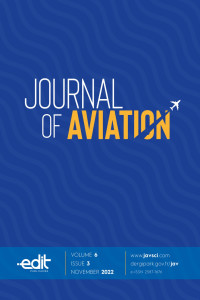Research Article
Year 2022,
Volume: 6 Issue: 3, 266 - 274, 22.11.2022
Abstract
References
- Antwi, Elijah Kwabena, Kui Liu, and Hao Wang. 2018. “A Review on Ductile Mode Cutting of Brittle Materials.” Frontiers of Mechanical Engineering 13(2): 251–63.
- Chen, Shun Tong, and Kai Chieh Yang. 2022. Semi-Ductile Cutting Regime Technology for Machining Zerodur Glass-Ceramic Microstructures. Precision Engineering 74(2022): 92–109.
- Döhring, Thorsten et al. 2009. Heritage of ZERODUR® Glass Ceramic for Space Applications. Optical Materials and Structures Technologies IV 7425 (2009)
- Ecss. 2012. Space Engineering - Testing. Ecss-E-St-10-03C (2012): 1–128.
- Esmaeilzare, A., A. Rahimi, and S. M. Rezaei. 2014. Investigation of Subsurface Damages and Surface Roughness in Grinding Process of Zerodur ® Glass-Ceramic. Applied Surface Science 313: 67–75.
- Komanduri, R., D. A. Lucca, and Y. Tani. 1997. Technological Advances in Fine Abrasive Processes. CIRP Annals - Manufacturing Technology.
- Lawn, B. R., and M. V. Swain. 1975. Microfracture beneath Point Indentations in Brittle Solids. Journal of Materials Science 10(1): 113–22.
- Li, Kun, and T. Warren Liao. 1996. Surface/Subsurface Damage and the Fracture Strength of Ground Ceramics. Journal of Materials Processing Technology 57(3–4): 207–20.
- Sakai, Mototsugu. 2020. INDENTATION CONTACT Micro / Nano Physics of Materials. REVISED ED.
- Steele, William A et al. 2021. Subsurface Mechanical Damage Correlations after Grinding of Various Optical Materials. 58(9).
- Wang, Huadong et al. 2021. Evaluation of Subsurface Damage Layer of BK7 Glass via Cross-Sectional
- Surface Nanoindentation. Precision Engineering 67(October 2020): 293–300.
- Xavier Tonnellier. Precision Grinding for Rapid Manufacturing of Large Optics, PhD Thesis.
- Zhenqiang Yao, Weibin Gu, Kangmei Li. Relationship between Surface Roughness and Subsurface Crack Depth during Grinding of Optical Glass BK7.
Investigation of Characterization of Zerodur Glass Ceramics Used in Aerospace to Predict the Relationship between Surface Roughness and Subsurface Damage
Abstract
Due to the brittle nature of the optical parts used in the grinding process to obtain a good surface quality, surface roughness and subsurface damage occur after the machining. These subsurface damages must be detected and destroyed with the help of post-process processes such as polishing. Because detecting these damages is time-consuming and costly, many researchers have tried relationship between subsurface damage and surface roughness since it is easier to detect and measure. In this study, Zerodur glass ceramic material characterization tests were carried out to predict the surface roughness and damage under the surface, and the material properties were determined to be specific to the sample. The grinding parameters taken from the previous studies and the values given for surface roughness and subsurface damage were examined with the help of the Lambropoulos theoretical model. The results theoretically showed that with the characterization of material properties different from those given in the literature, even if the parameters used in the experimental study do not change, much more severe subsurface damage will be created on the sample, and the load value applied to the material will increase significantly. For this reason, it is crucial to determine the material's mechanical properties by performing characterization tests before all material grinding and post-processing processes.
References
- Antwi, Elijah Kwabena, Kui Liu, and Hao Wang. 2018. “A Review on Ductile Mode Cutting of Brittle Materials.” Frontiers of Mechanical Engineering 13(2): 251–63.
- Chen, Shun Tong, and Kai Chieh Yang. 2022. Semi-Ductile Cutting Regime Technology for Machining Zerodur Glass-Ceramic Microstructures. Precision Engineering 74(2022): 92–109.
- Döhring, Thorsten et al. 2009. Heritage of ZERODUR® Glass Ceramic for Space Applications. Optical Materials and Structures Technologies IV 7425 (2009)
- Ecss. 2012. Space Engineering - Testing. Ecss-E-St-10-03C (2012): 1–128.
- Esmaeilzare, A., A. Rahimi, and S. M. Rezaei. 2014. Investigation of Subsurface Damages and Surface Roughness in Grinding Process of Zerodur ® Glass-Ceramic. Applied Surface Science 313: 67–75.
- Komanduri, R., D. A. Lucca, and Y. Tani. 1997. Technological Advances in Fine Abrasive Processes. CIRP Annals - Manufacturing Technology.
- Lawn, B. R., and M. V. Swain. 1975. Microfracture beneath Point Indentations in Brittle Solids. Journal of Materials Science 10(1): 113–22.
- Li, Kun, and T. Warren Liao. 1996. Surface/Subsurface Damage and the Fracture Strength of Ground Ceramics. Journal of Materials Processing Technology 57(3–4): 207–20.
- Sakai, Mototsugu. 2020. INDENTATION CONTACT Micro / Nano Physics of Materials. REVISED ED.
- Steele, William A et al. 2021. Subsurface Mechanical Damage Correlations after Grinding of Various Optical Materials. 58(9).
- Wang, Huadong et al. 2021. Evaluation of Subsurface Damage Layer of BK7 Glass via Cross-Sectional
- Surface Nanoindentation. Precision Engineering 67(October 2020): 293–300.
- Xavier Tonnellier. Precision Grinding for Rapid Manufacturing of Large Optics, PhD Thesis.
- Zhenqiang Yao, Weibin Gu, Kangmei Li. Relationship between Surface Roughness and Subsurface Crack Depth during Grinding of Optical Glass BK7.
There are 14 citations in total.
Details
| Primary Language | English |
|---|---|
| Subjects | Aerospace Engineering |
| Journal Section | Research Articles |
| Authors | |
| Early Pub Date | November 21, 2022 |
| Publication Date | November 22, 2022 |
| Submission Date | August 18, 2022 |
| Acceptance Date | September 10, 2022 |
| Published in Issue | Year 2022 Volume: 6 Issue: 3 |
Journal of Aviation - JAV |
This journal is licenced under a Creative Commons Attiribution-NonCommerical 4.0 İnternational Licence


